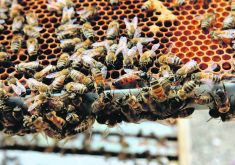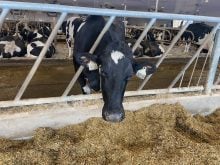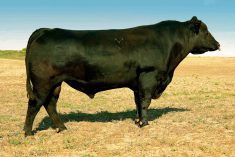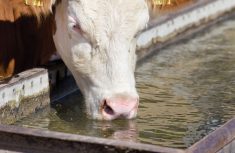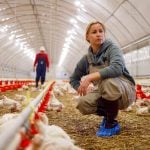Imagine a situation in which meat containing antibiotic-resistant bacteria ends up on the dinner plate of a consumer, who in turn ends up in the hospital with an infection which may not be treatable.
That’s the kind of nightmare scenario Dr. Leigh Rosengren envisions when she warns livestock producers about the risk of antimicrobial resistance in veterinary drugs.
Fears that antibiotics given to food animals could produce drug-resistant infections in humans are mounting, following an increase in cases of antibiotic-resistant bacteria detected in hospitals.
Read Also

Hands-on with agriculture draws students to AG EX
Urban students flock to MooMania and EweMania at Manitoba AG EX 2025 to get a taste of cattle and sheep production and where their food comes from
For livestock producers, who have traditionally given non-therapeutic levels of antibiotics in feed as growth promoters for pigs, poultry and beef cattle, there’s good news and bad news.
The good news is that so far the risk of zoonotic transfer (the transmission from an animal host to a human) of antibiotic-resistant bacteria is small. The bad news is that it’s possible.
“If a person eats a resistant bacteria from an animal, there is a concern for treatment failure,” Rosengren, a veterinary epidemiologist and private consultant, said after a June 13 presentation to a producer meeting sponsored by Elanco.
“The risk, although very slight, is if a resistant bacteria travels from an animal, contaminates a piece of meat, a consumer handles that meat inappropriately and doesn’t cook it properly. That consumer theoretically can get sick and, if the resistance is to a drug the doctor wants to treat them with, may experience a negative health outcome.”
Miracle drugs
When antibiotics were first introduced in the 1940s, they were considered miracle drugs which saved lives by healing infections. But their steady overuse has resulted in MRSAs (methicillin-resistant Staphylococcus aureus) — so-called “superbugs” responsible for bacterial infections which are either difficult to treat or not treatable at all.
At present, the most acute problem is in hospitals. But is an epidemic of drug-resistant bacteria occurring on the farm, too? And, if so, could superbugs jump the species barrier from animals to people?
In response to these concerns, Health Canada and the Canadian Animal Health Institute recently decided to gradually remove growth promotion claims from the labels of antimicrobial drugs used in animal production and to bring therapeutic uses of such drugs under veterinary oversight.
The action is in line with a similar initiative by the U.S. Food and Drug Association.
But that still falls short of banning the non-therapeutic use of antimicrobials in livestock, which medical and consumer groups are beginning to demand.
Rosengren admitted Canada has some of the developed world’s most permissive regulations about what may and may not be done with antimicrobials. She emphasized access to these drugs is not a right and producers need to limit their use because society and governments are starting to question producers’ ability to use them responsibly.
- More from the Manitoba Co-operator: Coming clean on antibiotics
Counter misperceptions
That said, producers should counter public misconceptions about how antibiotics are used on farms, Rosengren said.
She said the notion that antibiotics are fed to pigs throughout their entire growing stage is wrong. According to industry officials, Manitoba pork producers give nursing pigs antibiotics mainly to prevent diarrhea occurring during the transition from milk to solid feed. Feeders, growers and finishers may receive a few weeks’ worth of preventive medication during commingling. But as a rule, antibiotics are given post-nursing only to sick animals requiring individual treatment.
Rosengren said producers should make sure they’re using veterinary drugs responsibly and be more active in communicating that information to the public.
“They need to realize that, although antibiotic-resistant material is a public health threat, they are doing a lot of things right on their farms and they need to speak up about that message,” she said.
“At the same time they’re speaking out, they need to go home and make sure they always use the absolute best practices to minimize any continued use of resistance.”
Rosengren said she believes the danger of drug-resistant bacteria on farms may be overstated. She said a 2013 survey by the U.S. Centres for Disease Control and Prevention identified 18 major threats posed by antibiotic-resistant infections resulting from heavy antibiotic use. Only three were farm related. The most resistant organisms came from hospitals.
Rosengren said there is also less antibiotic use in livestock than there was five to 10 years ago, especially with the advent of alternative products such as ractopamine (sold by Elanco under the product name Paylean) and ionophores. Both are non-antibiotic feed additives used to increase feed efficiency and weight gain.
It’s all the more important to use antimicrobial drugs judiciously because there are no new ones on the horizon, she added.
“The tool kit we have today to work with is all we’ve got. If we burn these drugs out and they don’t work because of resistance, we’ve got no new silver bullet coming.”



